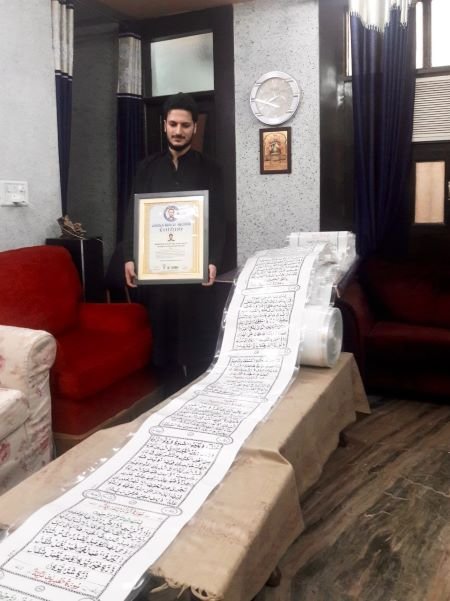NEW DELHI: When Mustafa Jameel began to study Arabic calligraphy in 2016, he practiced it to improve his handwriting — an effort that six years later resulted in a record-winning Qur’anic manuscript, and stirred the young calligrapher’s hope to display it in the Middle East.
Born in Gurez Valley, in the northern Bandipora district of Indian-administered Kashmir, Jameel completed his work earlier this year. In late May, the 27-year-old was registered by India’s Lincoln Book of Records in New Delhi for the “new world record for the first time in the world to write the Holy Qur’an on a 14.5 inch and 500-meter scroll paper.”
In Muslim societies, calligraphy is not only the art of properly forming written characters. Known as khatt (line) in Arabic, it signifies “the art of the line.” This art has not only been written in Arabic, but also numerous other languages that have adopted the same alphabet following the spread of Islam, including Persian, Urdu, Ottoman Turkish, and even old Malay.
There are a variety of graphic styles which calligraphy masters have developed throughout the ages. The oldest script used for copying the Qur’an is Kufic, a square and angular script which by the 11th century went out of general use, replaced by Naskh — a cursive style which until today remains one of the most popular scripts in the Arab world.
Naskh is also the style that Jameel used in his manuscript, which he learned by observing the work others had produced.
While calligraphers usually follow an established master, there have been countless exceptions to the rule, as many practitioners have learnt the artform through repetition and consistency.
“I learnt calligraphy by myself. I am self-taught,” Jameel told Arab News. “I am a first-generation calligraphist. There is no one in my family who is involved in calligraphy.”
He focused on the art after failing in his secondary high school exam. After a year of laborious study, he noticed his writing improving and focused all his efforts on copying the Qur’an.
“Then in 2021 the idea came into my mind that I can do this work properly, and if Allah has given me this talent, I should do the work of (copying) the Qur’an in a proper and professional manner. Then I thought that I should prepare the Qur’an in a single paper,” Jameel said.
The kind of paper he needed was not available in Kashmir, so he went to New Delhi and after finding the right scroll began to copy the scripture. The whole project was financed with the help of his relatives.
“I finished the whole project in Delhi,” he said. “It took seven months to finish and get the work laminated,” he said.
After he made headlines in India, now Jameel’s dream is to show his work abroad, especially in the Middle East, where the art of calligraphy is where the art of Islamic calligraphy is known and recognized.
“I would like to exhibit it in Dubai, where such creativity gets appreciated,” he said. “There is a museum in Madinah, and if I get an opportunity to exhibit my work there, I would love to do that.”
The most important appreciation, however, he has already won by making his family proud.
“When I could not clear my math in 10th standard, my family was very upset and lost hope in me. They would say that I would not do anything in life. But now they understand that Allah sends all individuals with different talents to this world,” he said. “My family is very happy now.”

